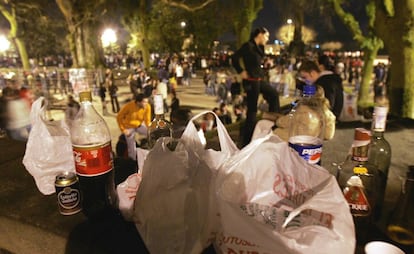Cellphones and alcohol: a recipe for sexual harassment in Spain
Young women are particularly at risk of suffering from new forms of violence such as sextortion, revenge porn and cyberstalking

It’s Saturday night in Madrid, and the area around Atocha station is buzzing with young people walking into or out of nearby nightclubs. Some of them are holding a can of beer, others a cigarette. Everyone has a cellphone in their hand.
“There’s no party without a picture, no blowout without an [Instagram] story. You have to immortalize the top moments, right?” says Jorge, a college freshman. All around him, flashes go off as friends take selfies. Many of them say there is one other thing that no self-respecting party can go without: alcohol.
I’m afraid of WhatsApp and Instagram, because of what I might find
Clara, victim of “slutshaming”
The combination of excessive drink consumption, cellphones and social media has spawned new forms of sexual violence that mostly affect women, and whose consequences are even greater in small-town environments.
The cultural anthropologists Nuria Romo and Laura Pavón have been studying this trend for the last two years. Their qualitative study, No sin mi móvil: consumo de alcohol, violencia de género y tecnología en la cultura española de la intoxicación (or, Not without my cellphone: alcohol consumption, gender violence and technology in Spain’s culture of inebriation), shows that drinking large amounts of alcohol in a short space of time “is an essential part of the experience for both women and men.”
This practice “is used as a tool for shedding inhibitions, facilitating interpersonal relations.” In this context, says Romo, “gender violence is linked to the use of cellphones in relationships, whether among friends or by a couple.”
The research, based on 24 in-depth interviews with 16- to 22-year-olds of both sexes, shows that women are more likely than men to suffer from sexual harassment and damage to their public image through the use of information technologies.
Every Sunday, Clara is scared to check social media. “I’m afraid of WhatsApp and Instagram, because of what I might find.” It’s happened to her more than once. At her 18th birthday party, a photo boomerang (a GIF-like series of pictures that look like a one-second video) ended up in several WhatsApp chat groups. The images featured her, kneeling in the middle of the street with her mouth open while someone pours rum into it. A young man is seen standing behind her, his fly partially unzipped and his semi-exposed penis near her neck.
“That did the rounds for days. They told me they were going to put it up on Instagram, that they were going to tag it #bitchdrinkin… I felt so bad that I stayed away from university for several days,” she recalls.
We know very little about the real number of victims, or the prevalence of the damage
Laura Pavón, researcher
There is a name for what happened to Clara: “slutshaming.” Laura Pavón defines it as “criticizing, shaming and constraining girls for behaving in a way that is viewed as promiscuous or outside traditional gender roles.”
The latest national survey on drug use among high school students, ESTUDES, shows a higher prevalence of alcohol consumption among teenage girls: 76.9% compared with 74.3% among boys. And there are growing numbers of 14- to 15-year old girls who report consuming large amounts of alcohol.
Sometimes, the venues themselves contribute to this. “Some bars let the girls in for free while the guys have to pay,” complains Sandra, 25. Jorge adds that girls get “no cover charge, free shots, two-for-one specials ... it costs them a third less to get drunk than it does us guys.”
In a similar vein, the fifth annual report by the Noctámbul@s Observatory, run by the Health and Community Foundation, states that entertainment venues encourage the sexualization of women’s bodies. Aware of this image, the industry association Spain Nightlife issued a report in mid-March asserting that assaults inside nightclubs are “residual” occurrences, and have dropped by 11.84% over the last year.
“Evidently we will work to prevent the harassment of women while they are having fun, but fortunately these cases are isolated,” said association president José Luis Benítez.
But Ivet Oriols, a sociologist and researcher at Noctámbul@s, says this view denies the structural nature of harassment. “In order to end this situation, it is necessary to end the feeling of impunity, and train personnel with a gender perspective.”
Romo believes that in order to make young women safer, “we need to consider the new vulnerabilities created by technology and alcohol, and use new strategies that adapt to young people’s new behavioral patterns.”
But Pavón says there is not enough data to work with. “We know very little about the real number of victims, or the prevalence of the damage. Thus the importance of research to guide prevention strategies, also in settings that have received little attention such as rural areas.”
Small-town effects
Pavón has conducted a separate study among 18- to 24-year-olds in rural areas of northern Extremadura. “You see forms of control, harassment, monitoring and extortion within relationships and outside of them,” she says. Pavón has come across numerous cases of sextortion, revenge porn and cyberstalking against young women in small-town settings.
Ana, a 15-year-old high school student from a village in Albacete province, has had personal experience with some of these forms of cyberviolence. Last summer she “hooked up with a boy” who was two years older than her, and for a month and a half the relationship was “perfect.”
“It was all so nice and so cool that I became more trusting, and after going out and drinking together I would go back home and send him pictures of myself. You know, without a lot of clothes on ... then we broke up because I found out he was dating another girl from another village,” she recalls.
In 2018, there were 1,702 rape complaints and 12,109 reports of other kinds of sexual assault
That was when he started threatening to share those images with his friends on WhatsApp. “I was scared shitless. Imagine if he sent them and my brother, my parents or my teachers ended up seeing them.”
In small towns, where people have more personal contact with one another, the emotional consequences for victims can be particularly hard. “There is more criticism, judgment and social sanction against their actions. As a result, there is more silence and invisibility of the reality of sexual and gender violence in the villages,” says Pavón.
Ana says that every time she walked down the street, she had the feeling that everyone was staring at her. “There were days when I didn’t even want to leave the house. I was going nuts thinking that people might have seen those pictures. If that happens, you are branded a slut forever.” As for her mother, “she would have had a heart attack.”
The figures
According to Noctámbul@s, 97% of young women who go out at night have experienced harassment at least on one occasion. Reports of crimes against sexual freedom grew last year: there were 1,702 rape complaints filed in 2018 compared with 1,387 in 2017, and 12,109 reports of other kinds of sexual assault, up from 10,305 in 2017.
A detailed analysis by the Interior Ministry released in October 2018 also shows that 50% of victims were underage. Experts blame this on the growing use of new technology: “According to the latest figures from the National Statistics Institute, practically 100% of minors regularly access new technologies and social media.”
English version by Susana Urra.
Tu suscripción se está usando en otro dispositivo
¿Quieres añadir otro usuario a tu suscripción?
Si continúas leyendo en este dispositivo, no se podrá leer en el otro.
FlechaTu suscripción se está usando en otro dispositivo y solo puedes acceder a EL PAÍS desde un dispositivo a la vez.
Si quieres compartir tu cuenta, cambia tu suscripción a la modalidad Premium, así podrás añadir otro usuario. Cada uno accederá con su propia cuenta de email, lo que os permitirá personalizar vuestra experiencia en EL PAÍS.
¿Tienes una suscripción de empresa? Accede aquí para contratar más cuentas.
En el caso de no saber quién está usando tu cuenta, te recomendamos cambiar tu contraseña aquí.
Si decides continuar compartiendo tu cuenta, este mensaje se mostrará en tu dispositivo y en el de la otra persona que está usando tu cuenta de forma indefinida, afectando a tu experiencia de lectura. Puedes consultar aquí los términos y condiciones de la suscripción digital.
More information
Archived In
Últimas noticias
Most viewed
- Sinaloa Cartel war is taking its toll on Los Chapitos
- Oona Chaplin: ‘I told James Cameron that I was living in a treehouse and starting a permaculture project with a friend’
- Reinhard Genzel, Nobel laureate in physics: ‘One-minute videos will never give you the truth’
- Why the price of coffee has skyrocketed: from Brazilian plantations to specialty coffee houses
- Silver prices are going crazy: This is what’s fueling the rally










































